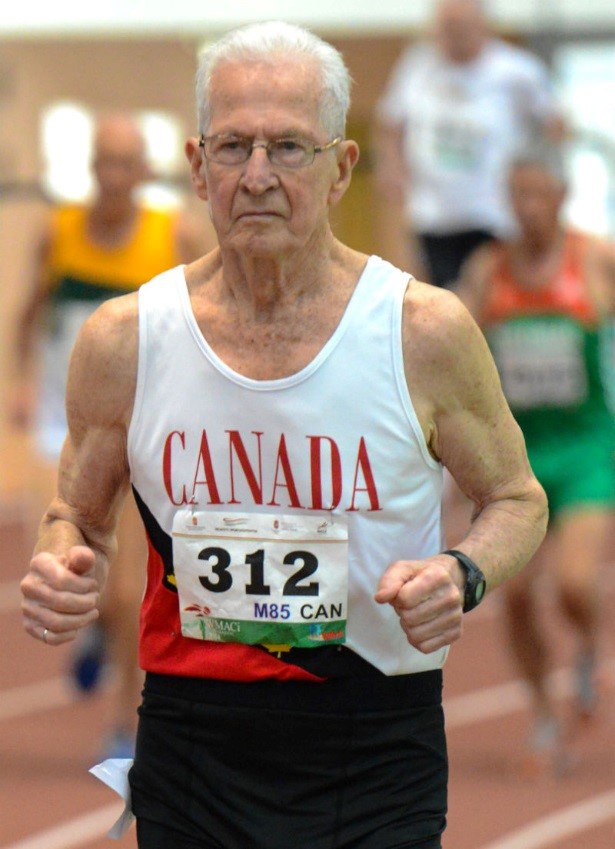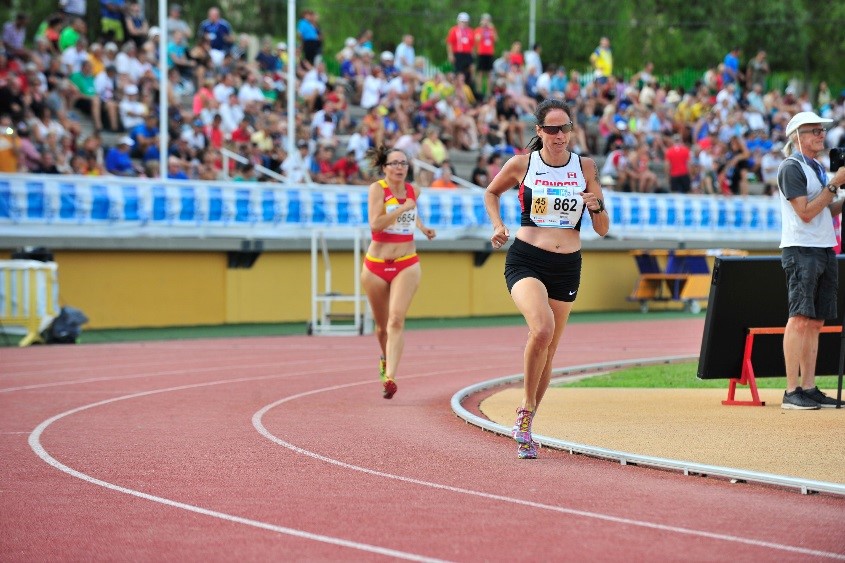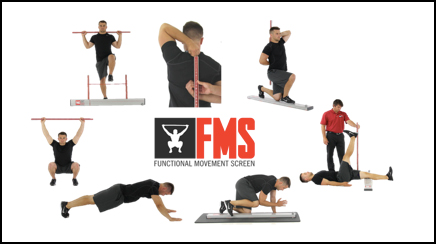Track and field for Masters Athletes 3: Physical assessment
News Article / February 21, 2020
Click on the photo under “Image Gallery” to see more photos.
This is the third in a series of articles covering all aspects of Masters Athletes’ training and nutrition for track and field events. Here, we will take a look at getting a physical assessment, which is essential before you can start planning your training program.
By Major Serge Faucher
No Masters athlete, no matter how fit you think you are, should just jump in and begin track and field training (or any other high-intensity sport such as cross-fit or hockey) without knowing your baseline.
As a Masters athlete, my wife is perhaps the best example I can use to illustrate this. In 2017 at age 43, she decided to switch from distance running to track and field, with the aim of running the 400m and 800m at a competitive level. While she had raced everything up to the marathon with some success, she was completely unprepared for what was coming!
While they both involve running, track and field and road running are two completely different animals! In her own words, “I thought I was in shape until I began my new training program for track and field”. Despite being careful, and slowly increasing her weekly workload and taking many other precautions, she almost immediately developed a series of nagging injuries such as a plantar fasciitis, both Achilles tendons, and a quad problem linked to weakness in the hip flexor, that would persist throughout her first year of training. She did overcome these problems in time, but they could have been minimized or even avoided.
While all runners eventually get injured, we could have minimized the damage by keeping the intensity and speed at a much lower level in those early months. Additionally, had she had a proper assessment done, she could have first focused on areas of weakness, and worked to strengthen them though a specific weight training program coupled with flexibility and mobility exercises.
(I will cover injuries and how to prevent them in a future article; injuries are not the focus of this particular piece.)
Again, you will need to determine your strengths and weaknesses through various assessments. I would propose that you enlist one of your local fitness and sports instructors [Personnel Support Programs (PSP) staff] or a competent sports physiotherapist, as they are qualified to make such assessments.
One of the tools I see used during assessments of CAF members is the Functional Movement Screen (FMS).
The FMS is intended to serve as a screen to set a baseline for individuals, and also to identify functional movement deficits that could indicate an increased risk of injury. The FMS was developed in 1997 to help clinicians and health care professionals screen individuals for risk of injury and/or a dysfunctional or performance-limiting movement pattern.
Your friendly local PSP staff will aim to identify imbalances in mobility and stability during seven fundamental movement patterns. These movement patterns are designed to provide observable performance of basic locomotors (squatting, lunging, , etc.) by placing an individual in extreme positions where weaknesses and imbalances become noticeable if appropriate mobility and motor control is not utilized.
The seven following movement patterns are scored from 0 to 3 points, with the sum creating a score ranging from 0 to 21 points. They are the deep squat, hurdle step, lunge, shoulder mobility, active straight leg raise, trunk stability push up, and rotary stability. While research to date is not yet clear for which sports the FMS is optimal in predicting injury risk, it’s believed that athletes who score less than 14 points have greater odds of sustaining an injury.
I had one of the PSP staff screen me on October 17, 2019; I scored 15/21. While I’m extremely fit (I scored 399 points on my last Force Test) and somewhat more mobile than other members in my age group, I still expected this low score due to certain limitations I have based on past injuries. The result was that I should work harder in improving my hip mobility and balance.
Aside from this, it seems that I need more overall mobility on my left side, which came as no surprise to me because I’ve been treated for significant scar tissue in my left hip area over the past 37 years.
From there, it’s up to us as individuals to start a program of corrective exercises with the goal of preventing musculoskeletal injuries.
In addition to developing your general levels of mobility as seen above, you need to consider the specific mobility requirements for the specific sport or track and field event you plan to get involved in. A qualified coach can analyze the technique of your event, identify which joint actions are involved, and determine what needs improvement in terms of range of movement. A thrower, for example, might require improvements in his shoulder and spine mobility, while a hurdler might need more hip mobility. In other words, it may be valuable to create a baseline, and measure the range of movement for particular joint actions to determine the present range, and track any future improvements as you progress from season to season.
For most aspiring athletes, I recommend hiring a coach. He or she may ask you to provide some basic information such as the event you want to compete in; how many times each week you plan to train; what your objectives will be for this season, year, next few years; your work hours, injuries, illnesses, family support; etc. The goal is to get a thorough assessment, and to identify both the ideal attributes that will allow you to achieve your goals, and the areas of potential weakness (red values in Table 1). Addressing the gaps may require you to think in terms of years, not months, but for the short term, this will help you set realistic goals to start training and to address the gaps in an intelligent way.
The RAST provides a test that can be used with athletes where running is the primary method of movement. RAST is used to test a runner's anaerobic performance, which is crucial for the 400m sprinter (about 48% of the race). This test is suitable for sprint, endurance athletes, and players of endurance sports such as soccer and hockey. The assessment below is an example of a test performed on a young athlete. Figures in red denote areas that will require focus.
Table 1 – Example of Athlete Assessment (including RAST and SCAT)
| Component | Ideal | Current | ||
|---|---|---|---|---|
| Endurance | VO2Max >55 ml/Kg/min | 52 | ||
| Speed | 100m < 13 Seconds | 12.4 | ||
| Anaerobic Endurance | RAST Max Power 676-1054 | 946 | ||
| Min Power 319-674 | 400 | |||
| Fatigue Index <10 | 12 | |||
| Strength (1RM) | Bench Press 1.25 X body weight | 1.1 | ||
| Leg Press 2.5 X body weight | 1.9 | |||
| Squat 2 X body weight | 1.6 | |||
| Leg curl 80% leg extension | 85% | |||
| Strength Elastic | Sergeant Jump Test >80 cm | 75 cm | ||
| Core Stability | Complete Core Stability Test | Completed full test | ||
| Body Composition | Body fat <11% | 14% | ||
| BMI 18.5 to 24.9 | 20.1 | |||
| Psychology | Score <15 on SCAT | 18 | ||
| Muscle Balance | Left | Right | % | |
| Hamstring (leg extension) | 75 | 85 | >10 | |
| Quadriceps (leg curls) | 60 | 70 | >10 | |
| Arm curl | 17 | 18 | <10 | |
| One arm military press | 18 | 20 | <10 | |
| Single leg press | 70 | 75 | <10 |
You may be fit physically, but are you mentally ready for competing in track and field or other demanding sports? The Sports Competition Anxiety Test (SCAT) is a test that determines the level of anxiety of an athlete by analyzing the athlete's responses to a series of statements about how she/he feels in a competitive situation.
Over the past 10 years, I have seen many track and field athletes crumble under pressure. The saddest I ever saw was at the 2019 World Masters Athletics Indoor Championships in Torun, Poland, where I witnessed the complete breakdown of a younger 400m sprinter just before running her semi-finals. She was obviously in distress before the official called “on your marks”; she was in tears, clearly not ready for the start. She ended up quitting at the 250m mark, breaking down in tears once again – the pressure was just too much.
That level of anxiety is such that it prevents individuals from enjoying competing and taking part in track meets. At times, I’ve also experienced severe cases of jitters as well. You feel sick to your stomach, and just feel like “scratching” the race a few minutes before you get in the blocks. But you must compose yourself, and focus on the task at hand. I was told by one of the greatest Canadian Masters of all time, Earl Fee, that the “butterflies” in your stomach never go away. He’s still competing at 91 years of age!
Following these assessments (FMS, RAST, SCAT, and others), you (and your coach) should have a good idea what your strength and weaknesses are, along with any imbalances in mobility and stability that need a bit of attention.
At this point, you have been assessed by a professional, you’ve found a competent coach you can trust, you have selected one or two events that you would like to train for, and you have started working on your mobility and other areas that need your attention. It’s time to start a training program. This program will have to be developed to meet not only your chosen distance, but also your individual needs, and take into consideration several factors such gender, age, strengths, weaknesses, objectives, available training facilities, and more. Since all Masters Athletes have different needs, a single program suitable for all athletes will not be possible. Unfortunately, it is common for a coach to give the same training to a group of athletes who will greatly differ in age. As an older athlete, be careful not to do too much or you will get injured very quickly.
So, by now, I will assume that you have chosen the 400m as your main event. This way, I can focus on one distance while I explain all aspects of training for it.
The next two articles will dive into the actual planning of your training program. The first, will focus on high-level planning, learning about periodization, training phases, and cycles. The next one after will get right down to weekly workout details.


